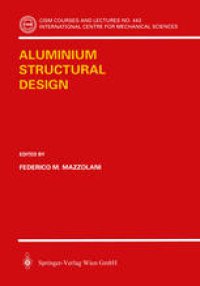
Ebook: Aluminium Structural Design
Author: Federico M. Mazzolani (eds.)
- Tags: Civil Engineering, Characterization and Evaluation of Materials, Theoretical and Applied Mechanics, Mechanical Engineering
- Series: International Centre for Mechanical Sciences 443
- Year: 2003
- Publisher: Springer-Verlag Wien
- Edition: 1
- Language: English
- pdf
The subject of the book is the design of aluminium alloys structures. The subject is treated from different points of view, like technology, theory, codification and applications. Aluminium alloys are successfully employed in the transportation industry; A parallel trend has been observed in the last decades in civil engineering structures, where aluminium alloys compete with steel (long-span roofing, bridges, hydraulic structures, offshore superstructures). This volume collects the lectures of out-standing international experts, who are all involved in the codification activity of Eurocode 9 on Aluminium Structural Design. It illustrates, with particular reference to the fields of transportation and civil engineering, the basic design principles from the material properties and the technological aspects of their application, to the evaluation of the resistance of the structural elements (member and plates) under static, dynamic and fatigue loading conditions.
The subject of the book is the design of aluminium alloys structures. The subject is treated from different points of view, like technology, theory, codification and applications. Aluminium alloys are successfully employed in the transportation industry; A parallel trend has been observed in the last decades in civil engineering structures, where aluminium alloys compete with steel (long-span roofing, bridges, hydraulic structures, offshore superstructures). This volume collects the lectures of out-standing international experts, who are all involved in the codification activity of Eurocode 9 on Aluminium Structural Design. It illustrates, with particular reference to the fields of transportation and civil engineering, the basic design principles from the material properties and the technological aspects of their application, to the evaluation of the resistance of the structural elements (member and plates) under static, dynamic and fatigue loading conditions.